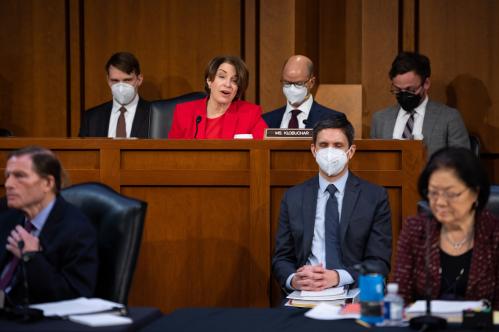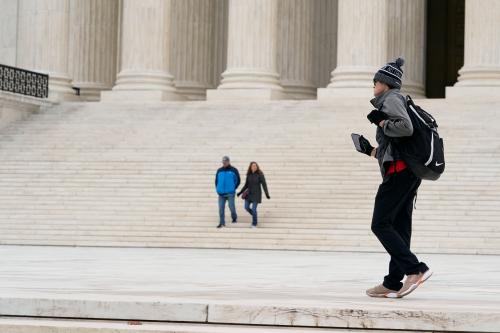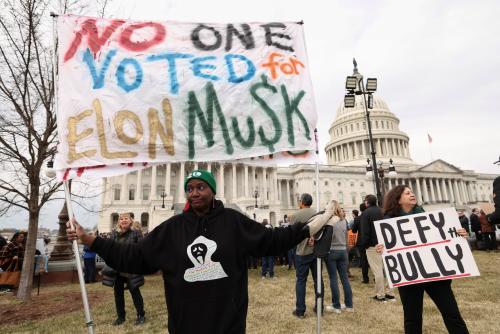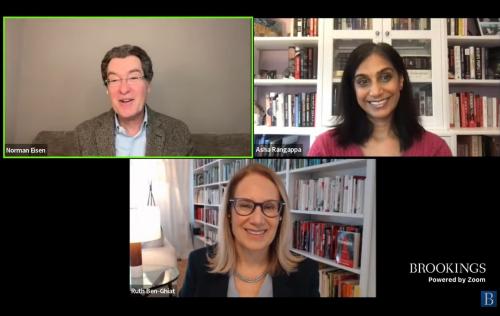In recent years, political campaigns have deployed dark patterns—innovative, but tricky and deceptive design techniques in emails and on web pages—to extract more donations from their supporters. With the use of prechecked boxes, small print, hard-to-understand language, and other tactics, campaigns have reaped millions when donors unknowingly give more than they intend. These deceptive techniques separate us from our money without our informed consent.
Courts have not settled concerns about how the First Amendment may or may not limit regulations of this sophisticated practice; how governments can stop dark patterns remains an open question. Current constitutional law about political speech also makes regulating this gray area even more critical.
As governments begin to wade into regulating dark patterns in the commercial context, the higher legal hurdle for political speech makes potential campaign fundraising regulations a distinct exercise from the commercial regulations. The Supreme Court considers campaign donations and campaign spending political speech. Political speech involves different First Amendment protections than commercial speech, where the state has a lower standard to meet to constitutionally limit speech. That means it is much harder to regulate campaigns.
But it is not impossible.
In this post, I argue that the Supreme Court’s view of money as a form of political speech should lead to an even greater call for a potential regulatory authority charged with curtailing the harmful practice of dark patterns in campaign fundraising. Put simply, to protect political free speech—the political donor’s participation in democracy—the government should curtail dark patterns where they apply to fundraising speech.
The Harmful Effects of Dark Patterns
Campaigns use different types of dark patterns to trick donors into giving more than they intend. After examining over 400,000 emails from 3000 campaigns, a study from Princeton University’s Center for Information Technology Policy revealed six different types of dark patterns: forward referencing, sensationalism, urgency, obscured name, an ongoing thread, and “Re: /Fwd.” During the 2020 Presidential election, organizations on both sides of the aisle, used tactics such as prechecked boxes and small, hard-to-read font to get donors to sign up for recurring payments. As evidenced by donor credit card disputes alone, these tactics accounted for at least $20 million in unintended donations to the conservative donation-processing site, WinRed. The total sum of manipulated donations—money that campaigns would not otherwise have received—is likely even higher, taking into account those who may have not meant to do a recurring donation but didn’t go through the refund process after they did. Not only that, but looking at the timeline of when more dark patterns were implemented, refund requests correspondingly surged. This campaign practice is now under investigation for fraud.
Altogether, the 2020 election demonstrates that dark patterns not only work but effectively create a mechanism for campaigns to go past regular advertising practices to a system where donors are more likely to give more than intended or do not know what they are giving. More broadly, dark pattern effectiveness has been studied, and the results demonstrated that the dark patterns represent a “quantum leap forward” in dangerous technological tactics, particularly when used in conjunction. Whereas before it would have been harder and more costly to trick consumers on a large scale, dark patterns show with a simple addition of tricky design techniques, campaigns can reap great undue benefit. Dark patterns thus are distinctly dangerous because of the potential scaling element and compounding effect they have.
The First Amendment Hurdle
Rightly, the Federal Election Commission (FEC) has been called in for regulatory guidance and enforcement, but current law keeps them powerless. In 2021, the FEC asked Congress to ban prechecked boxes, and legislation has since been introduced in the U.S. Senate. Without passing a bill that prohibits these practices, the public will continue to decipher the deceptive world of campaign fundraising dark patterns alone.
In this context and other dark pattern contexts such as in privacy and consumer law, the line between acceptable practice and impermissible harassment is murky. Put differently, limited action has been due to the legal interpretations of the First Amendment not being fully defined in this area. If a business nags (a type of dark pattern) a consumer to buy a product, is that protected by the First Amendment as just a sales strategy? That has not been fully litigated; even more critically, campaign fundraising dark patterns touch upon political free speech, which have higher barriers for regulation.
Therefore, questions linger on whether the First Amendment hurdle stops governments from protecting donors.
Wielding the First Amendment Against Dark Patterns
Yet, a more thorough analysis of the First Amendment jurisprudence on political speech reveals that instead of working against regulation, stopping campaign fundraising dark patterns would fulfill the First Amendment’s principle of democratic participation.
Rather than looking at regulation as stopping campaigns from free speech, we should look at how dark patterns effectively force the creation of free political speech. Let’s play this out. The Court has equated giving money to a political cause as a form of political free speech. Thus, if a dark pattern tricks a donor to give more than intended then that has forced more speech. Though Supreme Court precedent has famously struck down some campaign finance regulations, other analogous political free speech doctrine shows us that regulating to stop these dark patterns should be constitutional.
The Court has declared there is “no right more basic” than democratic participation in electing our political leaders. The Court recognized donating as part of democratic participation, and thus, allowing campaigns to deploy fundraising dark patterns would betray the “no right more basic” because it would not only disrupt this right but co-opt a person’s right by tricking them into donating more. Viewed in this way, the government should have authority to regulate campaign fundraising dark patterns to restore the donor’s right.
Further, we can look at other practices as evidence that regulating dark patterns is possible. For instance, mandatory disclaimer laws have been upheld. Laws around mandating disclosures are also generally legal. With regards to disclosure laws, the Court has generally held that while they “burden” speech, they do not impose a “ceiling” and represent a “less restrictive alternative” that ultimately arms the public with information. This is exactly the case with dark patterns and campaign fundraising. If dark patterns represent a design choice, then those creating them can choose a user interface that makes clear to the donor what they are doing. Stopping dark patterns arms the public with clear information and should represent the base floor for political donating.
Up against the highest constitutional hurdles, regulating campaign fundraising dark patterns is not only possible but clearly aligns with the fundamental principles of the First Amendment. Protecting donors only serves to bolster our democratic system against those that would extract money through manipulative psychological techniques. Let there be no doubt, between future campaign fundraisers deploying dark patterns and the government looking to curtail the practice, the First Amendment clearly sides with those protecting donors and democracy.
The Brookings Institution is committed to quality, independence, and impact.
We are supported by a diverse array of funders. In line with our values and policies, each Brookings publication represents the sole views of its author(s).







Commentary
The First Amendment can help stop dark patterns in campaign fundraising
February 17, 2022